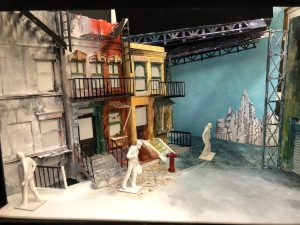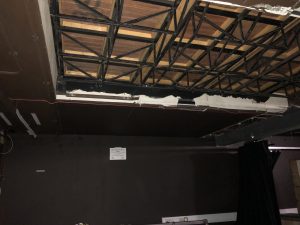Opera 2 would be an allocation of firsts for me. It’d be the first allocation I’d be seeing from white card to closing night, it’d be my first TSM allocation in the Ath, and – perhaps scariest of all – it’d be my first time flying a show. Looking back on the experience as a whole now as I write this, I’ve come to realise how much it has impacted my practice as a TSM, and the ways in which it has reaffirmed my belief in my ability and my outlook on how I can progress and develop over the next year.

Our Very Colourful White Card
From the outset this show was different. Adrian – our designer – requested to meet with Malki and myself before the white card to talk through all of the stage-specific aspects of the set. The reasoning for this became apparent when we first saw the 1:50 model. This set was huge. An apartment complex sweeping DSR to USC, a motorised garage door flat masking off the SL wing, and a rake that scooped the back third of the stage up and of to the wings. Above it all, three truss-like bridge sections and two washing lines, combining with all the other elements to create a 1940s New York Street Scene. It was visually spectacular, and a really special surprise. From this meeting, a couple of things started to jump out. Pit panels would need to be removed, as the action would take performers into the basement of the houses through walk-down traps in the stage floor. The garage door would have to be practical, preferably moving with a chain noise that Malki
assured could be a practical effect on stage. The windows would also have to function, with TSM taking on the responsibility of counterweight sashing them and weighting them. Then, Adrian announced his final idea. He would like the front cloth to iris out from DSL at the top of the piece, and iris back in at the end. Rarely have I seen Malki visibly excited, though this announcement seemed to push him quite close. Armed with a list of concepts to look into, we sat through the full white card presentation helmed by Alexandra – our director – and started to examine the practicalities of staging this immense show.
One minor issue that presented itself early on was the fact that our TSM wasn’t in the country. Dimitri had spent 6 months of third year completing an equivalency in Greece, a sabbatical that had not yet concluded during the white card and final design process. As such, we ended up Skyping and emailing excessively, with me taking on some of the immediate TSM roles – looking into the possibility of trap infills and the practicalities of fitting an orchestra in and around the treads. As much as this was a challenge, communication proved really good. Dimitri continued his regular phone call check ins – sometimes for no other reason than to check I was okay. Though he wasn’t geographically close, I still felt like he cared about the project and was there to support me; something I definitely valued. In a combination of both curiosity and boredom I took a laser measure and drew the Ath pit in Vectorworks. From this, I drew on the proposed trap positions, some deck and treads, with the dual intention of discovering whether this exercise would be possible, and showing the conductor how much room would be removed from the orchestra. This also resulted in the delightful finding that the furthest DSR palettes still had fibreboard underneath them, and this would have to be removed before we could make use of them at all; one of these pieces of the Ath’s design that is seemingly pointless, existing only to try our patience.

Because Fibreboard Under Removable Floor Panels is a Great Idea
And then – nothing. I was unable to attend final design, though from Malki’s notes, not a lot changed. The garage door would fly on automation, the iris would fly however the hell we could make it, and the set would arrive from workshop. It was March by this point, and Dimitri had returned to Scotland, bringing with him his trademark sunshine personality and carefree whimsy. In all truth, this was a blessing, as it allowed whatever small workload the TSM department had to manage to be taken up by someone other than myself, allowing me to take full advantage of the free time classes had given me to read, research, and write – an experience I have previously journaled about at length. During the production meetings I attended, nothing major came up – though concerns about the tightness of the schedule were persistent and perceivably unaddressed. Nevertheless, every department appeared to be progressing smoothly with no great obstacles standing in the way of being completed on time.
It’s rare that a lecturer phones you at home. Towards the end of the easter break I was doing some reading in bed when my phone started buzzing next to me. Of all the people I’d expected to be on the other end, the fact that it was Steve, searching for some rear-fold tab runners was quite alarming. These runners had been borrowed from Sottish Opera for the iris cloth, the rear-fold part meaning that the cloth wouldn’t bunch up as it swagged, keeping the leading edge sharp and achieving the desired look. Unfortunately, Scottish Opera wanted them back – and no one knew where half of them had gone. After my lack of knowledge of their whereabouts had been expressed to him on the phone, Steve would submit a plea to the Scene Dock facebook page before finally shelling out money from the Street Scene TSM budget to replace these items that neither Dimitri, or I, had seen or signed for. I have a few issues with how this panned out. The first, is that the quantity of these runners should have been checked when they were signed for. As much as Steve swore that we didn’t receive all that we had been expecting, the fact that this was assumed to be correct led to us buying replacements anyway. Secondly, there was no understandable reason for any other production to be using them, and the fact that they were not adequately secured away so that others couldn’t access them was an issue. Thirdly, and most telling, no one seemed to tell one another that they were in the building, or what they were being used for, or where they were being kept. As much as it may seem like yelling at a brick wall at this point, communication in RCS does not work, and information never seems to end up with the people it should. Nevertheless, with our TSM pocketbook considerably lighter, and our iris effect now cut in favour of a full black, we continued to prep for the fit-up.
SaveSave
